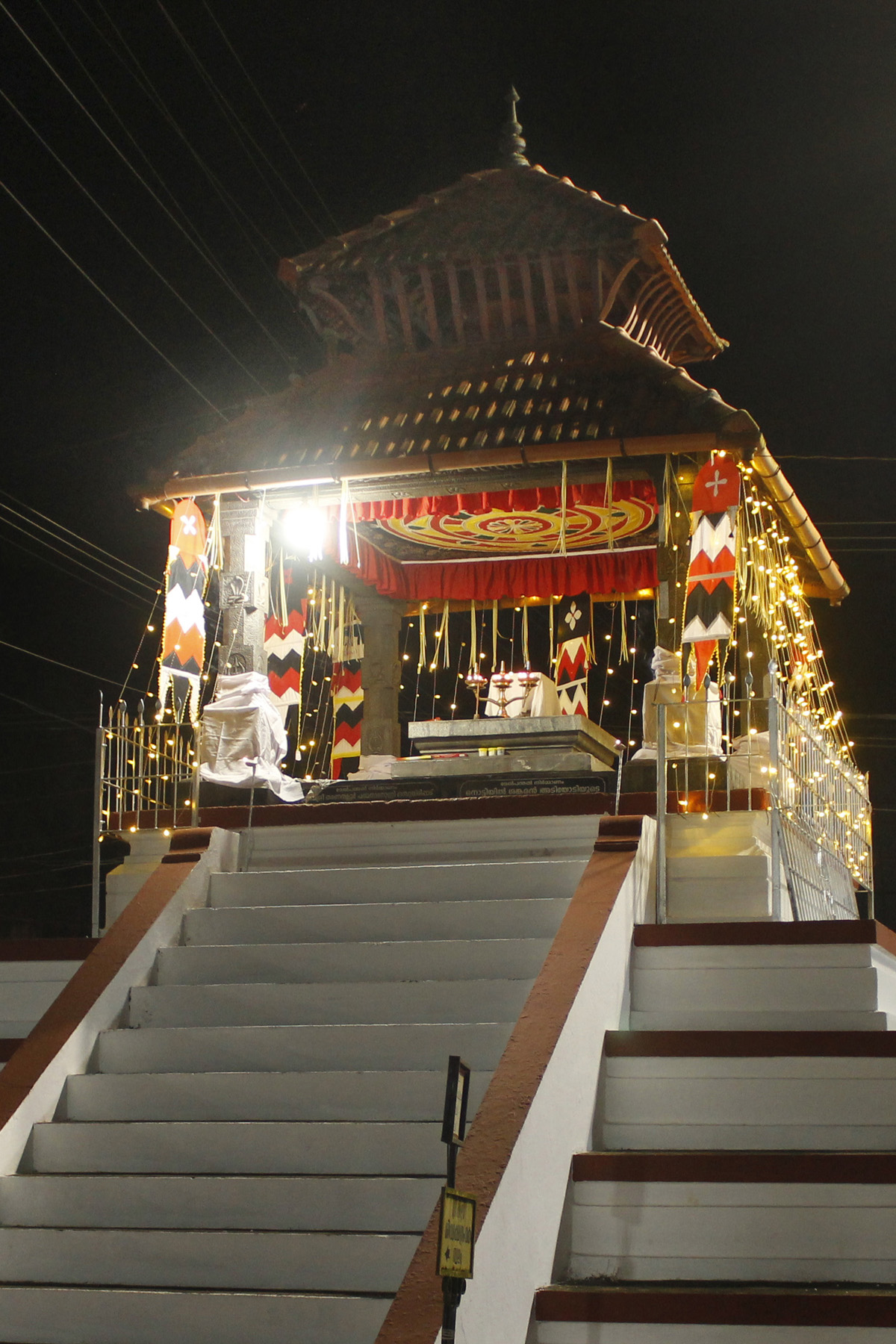About us
- Home
- About us

About us
Sri Kizhur Maha Siva Temple locally known as “Kizhur Ambalam” near Payyoli in Kozhikode district is one of the most famous temples in North Kerala. Legend has it that ‘the Karanavor of Kaippurath Matriarchal family’ at Kizhur used to visit the Muchukunnu Kotta Temple situated miles away regularly for worship. However with the old age, the ‘Karanavar’ was finding the up and down journey to the temple more and more difficult. On a rainy day the “Karanavar’ due to his old age could not attend the temple. On that day the Holy ‘Sivachaithanyam’ was incarnated on the wooden pillar of his house in the form of ‘Agni’ (fire). One will observe that the sanctum sanctorum and mandopam are jointly built along with the carved wooden idol in the form of a pillar, which resembles the structure of old ‘Kalappura’. Legend has it that when the fire was lighted the door shut automatically. To this day, the main door of the Sreekovil remains closed. Darshan is possible only through the small opening on the right side of the closed main door. Priests also enter the Sreekovil through this small door.
The Logans Malabar Manual records this temple centuries ago and has accorded it the same divinity and sanctity as the Sree Guruvayoor Temple. The intricate carvings, and engravings and mural paintings speaks of a time many centuries back and give a peek to the culture and grandeur of those times.
The Sree Tharananellur Illam, the old famous Taandric family who were inducted with the blessings and ‘kaivatta’ by Parasurama himself performs the tandric rights of this temple. Full circumambulation is allowed her ‘a feature unusual to most Siva Temples’. The darshan at this temple were ‘Shiva chaitanyam’ is worshiped as “Vatil Kappavar’ (Lord Siva who guards the fort of Bana) infuses peace of mind and consolation to devotees.
The main deity ‘Sree Vatilkappavar’ who showers benediction to the worshipful embodiment to countless devotees of all walks of life across the world. The very special traditional lamp with wooden support donated by the British Navigators who made the gift after they had a narrow escape at the Arabian sea and the right curved conch (valampiri shank) donated by the Dutch sailors proclaims the reputation of this shrine. The spinsters who perform ‘Uma Maheswara Pooja’ at the shrine get wedded soon.
The festival rites of this temple are carried out with the full co-operation of the devotees. It is noteworthy that 30 individuals from different caste and ancestry of Hindu Religion observes fasting (noyanbu) for 30 consecutive days to perform the rituals in connection with the annual festival. As per records the Cattle Fair conducted during the festival days was very popular standing next only to Vaniyamkulam fair.
The ‘Poovedithara’, a laterite square masonry construction having seven steps with the height of nearly 8 meters and spread over 100 Sq. Meters at Kizhur town were the idol will be taken on the annual festival day (Aarattu) for darshan and showers blessings to all and the ‘Prakkuzham Pattu Thara’ situated at Kizhur school junction were the rituals for the start up of annual rituals were a pride for the natives as well as a land mark and the passersby have a glimpse of the same with reverence .
Unfortunately the sands of history put the shrine through neglect till the 1950’s. The advent of the Land Reforms Act only hastened the temples dilapidation. As a result of this endeavor of Hon’ble Kerala Gandhi K. Kelappan, a committee named ‘Kizhur Siva Kshetra Paripalana Samithi’ with Sri V.V. Subrahmaniya Iyar, a prominent Advocate at its leadership assumed the responsibility of managing the temple in the year 1971. In the year 1974 the administration of the temple has been brought under the H R & C E (Admn) Dept. and later on transferred to the administrative control of Malabar Devaswam Board since its formation. The temple is now administered by a Trustee Board consisting 4 non-hereditary Trustees appointed by the Malabar Devaswam Board and 1 hereditary Trustee. Since the assumption of the administration of the temple from the hereditary ‘Uralans’ a good number of works a vast amount in Crores of rupees have been spent for the physical improvement of the temple as well as for Thandric Rituals for the up gradation of the spiritual power of the deity. All the works have been carried out with the full cooperation of the devotees coordinated by the Trustee Board and Samathi.
The devotees wait for an year to make offerings on the ‘Karakettu’ placed that the padippura on annual festival day ending 30 days of ‘Noyambu’. Similarly to have a ‘Niramala’ worship during the ‘Mandalam’ season is also an important vazhipadu for which the devotees have to wait for years for their turn.
Here we give a gist of certain works
- 1970 Preliminary discussion on take over of the temple
- 1971 Committee registration
- 1976 First Cultural / Medical / Commercial exhibition at Chovva vayal
- 1978 First renovation with the change of the idol
- 1980 Reconstruction of ‘Padippura’
- 1988 Sreekovil renovation
- 1995 Second renovation and ‘Dwaja Prathistha’
- 1999 Vishu pattu – Valiyakalm pattu – resumed after a gap of 50 years.
- 2000 Nagakotta punaprathishta after renovation.
- 2001 Melpanthal nirmanam, Dravya kalasam on Kodiyettam day – started
- 2002 Bhagavatha saptaham / Kalabhabhishekam – started / Pradakshina vazhi granite pavement
- 2010 Reconstruction of Nalambalam in full.
- 2014 Granite pavement of Tirumuttam/ Vettakkaran temple / Kovilakam construction
- 2015 Third renovatrion with ‘Dravyavarthi Dravya kalasam’.
- 2016 Renovation of Aaratu kulam’ started.
- 2020 Full replacement of Sreekovil roof including wooden structure and copper roof.


